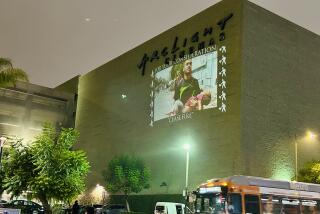Artist Aims to Humanize the AIDS Epidemic : Art: Mark Niblock-Smith’s posters in bus shelters around the city feature story snippets about everyday people living with the disease.
“These are intimate stories of people leading productive, positive lives with HIV,” says Los Angeles artist Mark Niblock-Smith, whose latest work, bus shelter posters called “AIDS--Little Stories, Big Concern,” went up this week at 60 locations citywide.
The 4x6-foot posters--in two versions--confront the viewer with a short block of large text, such as “Someone you know is very ill and they don’t know it. It might be you.” But the posters’ strength lies in more understated elements, small anonymous silhouetted profiles interspersed with story snippets of everyday people with AIDS. Some examples:
* He is a security guard and she is a waitress. They share a life in a comfortable apartment. They talk of a future together. In a few days, he will find a purple lesion on her back. This is the beginning.
* He was given only two years to live. That was seven years ago. In a few months, he’ll finish his graduate degree and travel to Mexico with his companion. When they return, they’ll sit down together and make a long list of wishes. Most will come true.
* Her friends no longer come to play. She is nine years old and has a difficult time understanding the changes happening to her body. She is very tired and asks her mother to explain, again, what all of this means.
For Niblock-Smith, 33, who has developed AIDS since being diagnosed with HIV in 1986, the project provided an opportunity to humanize the AIDS epidemic and deal with more than just its horrors.
“There’s been so much (scaring) the public about all the horrible things that happen to your body,” he said. “It’s not that that doesn’t happen but today, if you’re diagnosed and get aggressive therapy and treatment, you could live a good long life. (AIDS) is not about giving up. It’s about doing something and being aggressive. And that aggressiveness prolongs life even more--I know it has for me.”
Despite a lengthy bout with pneumonia in the spring that delayed the bus shelter and other projects, Niblock-Smith’s aggressiveness has kept him producing work for a number of recent solo exhibitions at sites including the Social and Public Art Resource Center and L.A. Center for Photographic Studies.
His works--installations addressing the environment, military expenditures, homelessness, religion and sexual orientation--have also been featured this year in several group exhibitions including Pasadena’s Armory Center for the Arts and Venice’s Beyond Baroque.
But the artist takes special pride in his AIDS-related public art projects, which have included a window installation at the Armory for A Day Without Art in 1990, inclusion in the L.A. Festival’s bus poster project “Busz Words,” and a billboard for an AIDS service center in Pasadena. In January, he will start applying for grants in the hopes of mounting an AIDS poster project in shopping malls.
“I just really feel a need to reach people. I felt as if I was preaching to the converted in the gallery system, and I realized that the way to communicate to a broader public is through public art,” he said, noting that bringing AIDS and HIV down to a personal level for that broader public was a main goal in the bus shelter project.
“I didn’t want this to be didactic,” he said. “I wanted the work to be intimate, accessible and personal, and I wanted there to be an emotional response.
“When you read stories about just average sorts of people living with it and leading productive lives, it humanizes AIDS and the HIV infection. People’s perception and feelings change when they know people in their life that are infected.”
Produced with the help of a $7,600 L.A. Cultural Affairs Department grant and shelter space donated by Gannett Outdoor of Southern California, the posters have also received the cooperation of AIDS Project Los Angeles and feature the organization’s hot-line number.
They will be on view at shelters in Hollywood, Mid-Wilshire, MacArthur Park, Echo Park, Chinatown, West Los Angeles and Westwood through January.
More to Read
The biggest entertainment stories
Get our big stories about Hollywood, film, television, music, arts, culture and more right in your inbox as soon as they publish.
You may occasionally receive promotional content from the Los Angeles Times.










